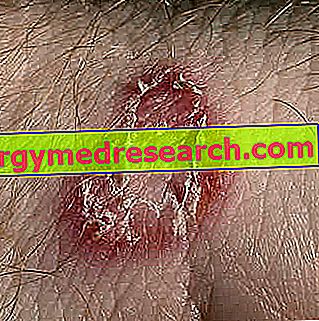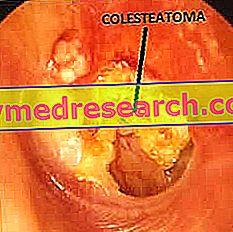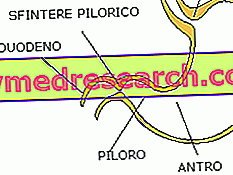Generality
Tinea corporis (or ringworm of the body ) is a fungal infection that affects the surface layer of the skin. This condition is caused by a group of fungi, called dermatophytes .

See More Photos Tinea Corporis
The tinea corporis manifests itself with the appearance of eruptions on the skin, consisting of small red blotches and flaking with a circular appearance, with a lighter central area and a slightly raised net edge. The evolution of these lesions is typically centrifugal: the spontaneous resolution at the center and the gradual peripheral progression determine the formation of an annular patch ( ringworm ). The ringworm rashes of the body can be itchy.
Other symptoms associated with the infection may vary depending on the area affected. Usually, tinea corporis involves the glabrous skin of limbs (arms and legs), trunk and some areas of the face; on the other hand, feet, hands and the inguino-crural region are never affected.
The treatment of tinea corporis involves the use of antifungal drugs to be applied locally to the skin or to be taken orally, according to the most appropriate regimen indicated by the doctor.
Causes and risk factors
Tinea corporis is an infection of the superficial skin ( dermatophytosis ), usually due to fungi of the species Trichophyton, Epidermophyton and Microsporum.
Dermatophytes are a particular type of microorganisms that infect the superficial portion of the skin (stratum corneum of the epidermis) and the skin appendages (hair, hair and nails), in which the presence of keratin is abundant, of which they feed.
As a rule, the fungi that cause tinea corporis are already present on human skin and in the environment, but generally they do not constitute any problem, as the skin surface and the immune system exert a natural defense and control action, avoiding excessive fungal proliferation. However, in the presence of some favorable conditions, these microorganisms behave as opportunists, ie they are able to "exploit" situations of immune weakness and overcome the resistance of the barriers of the human body, settling in the skin.
The fungi most commonly responsible for the onset of tinea corporis are:
- Trichophyton rubrum ;
- Microsporum canis ;
- Trichophyton mentagrophytes .
The eruption of the ringworm of the body is manifested, as a rule, on the parts without hair (glabrous skin), with the exception of feet, palms of the hands and inguino-crural region. Usually, the infection involves the torso, arms and legs.
How the infection occurs
Tinea corporis is a fungal infection that spreads quite easily through contaminated objects (such as towels, clothes, sports tools, hairbrushes, razors or other personal hygiene tools) or through direct contact with other people who already have contract the disease.
This dermatophytosis can also be transmitted by infected animals, domestic or wild, which come into contact with human beings, which can contract the infection by caressing them, lifting them or touching damaged areas. Sometimes the ringworm of the body can spread even through prolonged exposure to contaminated soil .
The incubation period is about 4-10 days.
Predisposing factors
The dermatophytes responsible for tinea corporis find the best situation for their development especially in the late spring and summer period, when the highest temperatures and high humidity rates favor sweating and stagnation of sebaceous secretions.
The excessive proliferation of these fungi of the skin can also be due to changes in the skin's pH, poor hygiene and excessive humidity of certain body areas, secondary to the habit of wearing tight and not very breathable clothes. Other risk factors include prolonged or frequent antibiotic therapies, use of cortisone drugs, chemotherapy, malnutrition, diabetes and other debilitating systemic diseases.
Who is most at risk
Tinea corporis can occur in both sexes, regardless of age.
However, they present a greater risk of contracting ringworm:
- Children;
- Breeders and veterinarians at frequent contact with animals (especially cats, dogs, rodents, cattle and horses);
- Subjects with states of immunodepression;
- People who live in crowded environments, especially in geographical areas where the climate is more humid and warm;
- Individuals who practice contact sports such as football, rugby or wrestling;
- Subjects already suffering from another dermatophytosis, such as tinea capitis (scalp), tinea faciei (face), tinea barbae (beard area), tinea cruris (groin), tinea pedis (foot) or tinea unguium (nails).
Dermatophytosis: key points
- Dermatophytosis is a fungal infection sustained by dermatophytes, able to parasitize exclusively dead skin structures and appendages, rich in keratin material (stratum corneum of the epidermis, hair and nails). These diseases affect men and animals, including cats, dogs, rabbits and other rodents.
- Predisposing factors such fungal diseases include over-sweating, a hot-humid environment and frequenting sports environments (swimming pools and gyms).
- Dermatophytosis occurs with clinical features that vary depending on the site of infection, but commonly involve redness, itching and skin flaking.
- Diagnosis is based on the clinical aspect and examination of skin scarifications in a fresh preparation with potassium hydroxide.
- The treatment involves the use of topical or oral antifungal drugs.
Signs and symptoms
At the skin level, tinea corporis is characteristically manifested by an erythema-desquamative eruption, consisting of patches with an annular appearance or elements with irregular and polycyclic contours .
The evolution of this lesion is, in fact, typically centrifugal: at the beginning, the ringworm eruption appears as a discoid macula which tends to extend outwards; subsequently, as the infection undergoes spontaneous resolution, the center of the lesion returns to a lighter color (rosaceous), while the outline remains reddish and in relief.
The tendency of the lesions to assume this ring shape (called ringworm ) is associated with a transient acquired resistance: the infectious process can be reactivated in the central areas of the patch, giving rise to a succession of concentric circles separated from each other by small areas of skin normal.
Injuries generally reach about 2-3 cm in size; however, with the passage of time, the neighboring annular patches can flow together giving rise to extensive eruptions . In addition, tinea corporis infection can spread to other parts of the body, especially when the affected subject does not resist the urge to scrape or touch existing lesions, favoring the dissemination of fungus spores.
Tinea corporis can cause itching and sometimes the skin surrounding the eruption can be very red, dry and scaly to the touch, due to the inflammatory state induced by the infection.
In some cases, more flogistic variants of tinea corporis are observed, characterized by scaly plaques covered with papules, vesicles and pustules, especially at the edges of the lesions. Rarely, however, forms of acute suppurative type (with inflamed and purulent sores) or chronic granulomatous can appear.
Extended and treatment-resistant eruptions generally occur in patients infected with Trichophyton rubrum and in patients with debilitating systemic diseases.
Diagnosis
The diagnosis of tinea corporis is formulated by the dermatologist on the basis of the clinical appearance of the rash and on the histological or cytological examination of a tissue sample.
The identification of the precise species of fungus in question can be confirmed by direct microscopic examination of fresh preparations of potassium hydroxide (KOH) and through the positive nature of laboratory cultures.
Differential diagnosis
Some tinea corporis infections can simulate other dermatological conditions, such as:
- Contact eczema;
- Pityriasis rosea;
- Tossidermie;
- Nummular dermatitis;
- Erythema multiforme;
- Tinea versicolor;
- erythrasma;
- Psoriasis;
- Seborrheic dermatitis;
- Secondary syphilis.
Furthermore, certain pharmacological therapies (generally, a treatment continued with topical corticosteroids) can significantly modify the clinical picture of the ringworm of the body, making it difficult to recognize, as they mask the most typical manifestations. In this case, we speak of "tinea incognita" .
Treatment
The treatment of tinea corporis depends on the severity of the clinical manifestations and, in general, involves the use of antifungal drugs to be applied to the skin or to be taken orally, based on the indications of the dermatologist specialist.
Most skin infections respond very well to topical antifungal preparations . Resistant cases or those with widespread involvement require the use of systemic therapy .
Topical therapy
If the ringworm of the body is mild to moderate, the doctor may prescribe an antifungal in cream, lotion or gel, such as imidazoles (miconazole, clotrimazole, econazole, ketoconazole), ciclopirox, naftifina or terbinafine.
The drug should be applied twice a day to the affected area for at least 7-10 days after the disappearance of the lesions, which generally occurs after about 2-3 weeks.
Usually, the inflammatory variants of tinea corporis also respond promptly to specific topical antifungal dressings.
Systemic therapy
In cases where there are several tinea corporis lesions or the infection is resistant to topical treatment, the most effective approach involves taking oral antifungals (itraconazole or terbinafine). These drugs should be taken once a day for 7 days.
To learn more: Drugs for the treatment of cutaneous mycoses "
Prevention and useful advice
Although tinea corporis is not easy to control, since the dermatophytes that cause it are common and very contagious, some measures can help reduce the risk of contracting mycosis and avoid a further spread of infection in a family or community environment.
Useful measures to prevent this dermatophytosis include:
- Respect adequate hygiene measures, such as washing hands regularly and keeping common areas clean;
- Avoid shared use of clothing, underwear, shoes, towels or hair brushes with other people;
- As far as possible, avoid favoring factors, such as excessive humidity and heat: to limit the attack of dermatophytes it is important to avoid excessive sweating and maceration from occlusive synthetic clothing;
- Follow a correct hygiene practice, especially when the practice of some sports involves physical contact with other people;
- If your pets show signs of ringworm (like a patch of missing hair), contact your veterinarian for proper treatment;
- Avoid direct contact with people or animals that have a suspected or certain infection with tinea corporis.
Furthermore, to avoid relapses it is important to observe an accurate hygiene and choose non-adherent garments, made with natural fabrics.



